LAB REPORT
Science and Technology Making Headlines
Oct. 23, 2020

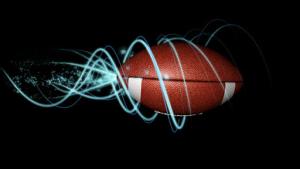
Researchers have found that a spiraling football’s trajectory is based on the odd behavior of gyroscopes.
Football vs. physics
A group of physicists, including Lawrence Livermore’s Willy Moss, were never amazing football players, but they’ve helped explain some of the magic when a quarterback goes deep.
Fans may marvel when a quarterback throws a deep pass. The ball leaves his hand, it points upward, in the direction of the throw. As it arcs through the air, spinning along the long axis without any visible wobble, the nose of the football dips, following the trajectory of the throw and pointing downward when it lands in the hands of the receiver.
But for physicists, they see something different that has befuddled them for years. What they see seems to conflict with a fundamental property of motion known as the conservation of angular momentum. It states that the axis of a spinning object, will not change its orientation unless some force acts to twist it. It was not clear what force could be pushing the football’s nose down.
But Moss and other researchers distilled the physics into two simple equations that could be solved numerically. The solution explains why the tip of the ball follows the ball’s trajectory and illuminates a simple qualitative explanation based on the odd behavior of gyroscopes.
The wind pushing on the tilted ball functions like a finger pushing on a gyroscope. The spinning ball moves at right angles to the push and wants to trace a circular path — called “precession” — around the current trajectory. The nose of the ball ends up tracing a circle around wind velocity direction, which is constantly changing, as gravity changes the trajectory.

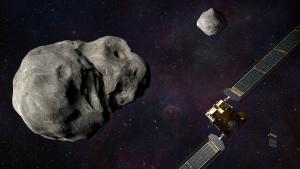
NASA’s DART mission is scheduled to crash into the moon of asteroid Didymos to change the asteroid’s course.
A spacecraft to save the world
NASA’s Double Asteroid Redirection Test, or DART, is expected to slam a cube-size spacecraft into a small asteroid orbiting a larger asteroid 7 million miles from Earth. No one is exactly sure what will happen when the probe impacts its target. The spacecraft will be obliterated, but it should be able to change the asteroid’s orbit just enough to be detectable from Earth, demonstrating that this kind of strike could nudge an oncoming threat out of Earth’s way.
Modeling a bunch of different possible shapes of the asteroid will help DART autonomously make decisions about where it should aim to crash on the surface. And by modeling the effects of different shapes and compositions of the asteroid, scientists can compare the results of their simulations with actual data from the collision.
The DART team has been working with the planetary defense crew at Lawrence Livermore National Laboratory to simulate the possible impact scenarios using two of the Lab’s supercomputers.
By studying the way that ejecta is thrown off the asteroid, they’ll be able to get a better idea of what it is made of and how this composition will affect the trajectory change.
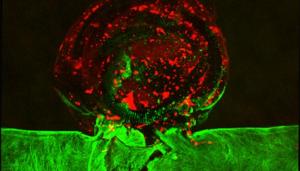
An LLNL team replicated an aneurysm in vitro and performed an endovascular repair procedure on the 3D-printed aneurysm. The green areas depict the endothelial cells and the red indicates the formed clot. Image by Elisa Wasson.
A less invasive way to treat aneurysms
Brain aneurysms affect about one in every 50 Americans and can lead to serious medical emergencies, including stroke, brain damage and death if they burst. Existing treatment options are limited and often invasive, and surgical outcomes can vary widely from person to person.
But medical practitioners may be able to improve existing treatment methods and develop new personalized ones, thanks to researchers at Lawrence Livermore National Laboratory and their outside collaborators. The team, which includes scientists at Duke University and Texas A&M, has become the first to produce a living, bioprinted aneurysm outside the human body, perform a medical procedure on it and observe it respond and heal as it would in an actual human brain.
An LLNL team led by engineers William “Rick” Hynes and Monica Moya were able to replicate an aneurysm in vitro by 3D printing blood vessels with human cerebral cells. Hynes performed an endovascular repair procedure on the printed aneurysm — inserting a catheter into the blood vessel and tightly packing platinum coils inside the aneurysm sac. After the packing treatment, the researchers introduced blood plasma and observed the formation of a blood clot where the coils were located, cutting it off from fluid flow.

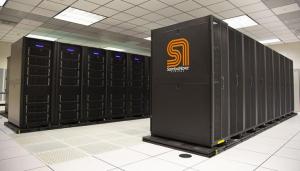
LLNL has installed a new artificial intelligence accelerator from SambaNova Systems into the Corona supercomputing cluster, allowing Lab researchers to run scientific simulations for inertial confinement fusion, COVID-19 and other basic science. Photo by Katrina Trujillo/LLNL.
Pump it up
Lawrence Livermore got a boost in computing from a state-of-the-art artificial intelligence (AI) accelerator from SambaNova Systems, allowing researchers to more effectively combine AI and machine learning (ML) with complex scientific workloads.
LLNL has begun integrating the new AI hardware, SambaNova Systems DataScale™, into the National Nuclear Security Administration’s Corona supercomputing cluster, an 11-plus petaFLOP machine that Lab scientists are using to conduct fusion energy research for stockpile stewardship applications, find therapeutics for COVID-19 and perform other unclassified basic science work.
Lab researchers said the upgrade will allow them to run scientific simulations on the Corona system while offloading AI calculations from those simulations to the SambaNova DataScale system, improving overall speed, performance and productivity.

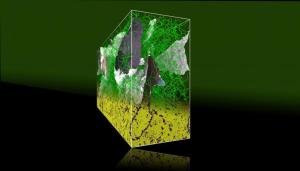
To understand how metals respond to high-rate compression in molecular dynamics simulations, LLNL scientists use novel methods of in silico microscopy to reveal defects in the crystal lattice (green and red line objects and gray surface objects) while removing all the atoms (yellow balls) for clarity.
The hard way
To solve a 100-year puzzle in metallurgy about why single crystals show staged hardening while others don’t, Lawrence Livermore National Laboratory (LLNL) scientists took it down to the atomistic level.
For millennia, humans have exploited the natural property of metals to become stronger or harden when mechanically deformed. Ultimately rooted in the motion of dislocations, mechanisms of metal hardening have remained in the crosshairs of physical metallurgists for more than a century.
The team, headed by LLNL materials scientist Vasily Bulatov performed atomistic simulations at the limits of supercomputing that are sufficiently large to be statistically representative of macroscopic crystal plasticity yet fully resolved to examine the origins of metal hardening at its most fundamental level of atomic motion. The simulations were performed on the Vulcan and Lassen supercomputers at Livermore and Mira supercomputer at Argonne Laboratory Computational Facility.





